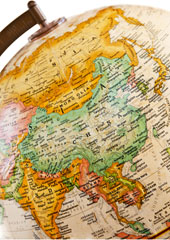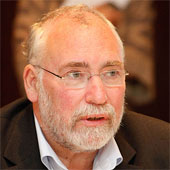Beyond Economic Integration: European Lessons for Asia Pacific?
Economic integration alone does not suffice to keep a dependable peace.
February 3, 2014

Well over a century ago, John Hay, who served as U.S. Secretary of State from 1898 to 1905, wrote: “The Mediterranean is the ocean of the past, The Atlantic, the ocean of the present, And the Pacific, the ocean of the future.”
Following the Spanish-American War (1898), Hay ensured that the Philippines became an American colony, thus providing the US with a base in Asia Pacific.
Furthermore, in 1899, he announced the “Open Door Policy” in China. Its purpose was to pre-empt any European power (or Japan) from colonizing China. Instead equal access should be granted to all. This marks the beginning of the United States’ strategic engagement with Asia.
As a matter of fact, through, throughout most of the 20th century, encompassing two world wars and the Cold War, the United States remained primarily fixated on the Atlantic.
Hay’s wisdom
Just a little over a century after John Hay’s tenure, and very much following in his footsteps, in October 2011, Secretary of State Hillary Clinton proclaimed the American policy of a “pivot” to Asia for “America’s Pacific century.” Hay’s vision took some time to materialize. But it is in Asia Pacific that the main narrative of the 21st century will be written.
That much seems certain. What is not at all certain, indeed far from it, will be what this (Asia) Pacific Century will look like.
Current blips and no doubt occasional future bumps notwithstanding, it is reasonable to assume that, by the middle of this century, Asia will account for more than half of global GDP.
With its growing economic clout, Asia has gained increasing global power. The large Asian emerging economies – China, India, Korea and Indonesia – are now part of the post-crisis global decision-making landscape.
Even if the G20 by and large fails to meet expectations, this global governance body provides emerging Asian economies with a sphere of influence that seemed out of reach only a decade ago.
Yet, Asia faces many risks: Inequalities within nations remain high and are increasing in the region’s emerging giants – China, India and Indonesia. Disparities between nations also remain high. Thus, if many present and future economic opportunities are in Asia, so are many global threats.
Asia’s opportunities – and risk factors
This is notably the case with respect to water, environment, energy and food. According to the International Energy Outlook 2013 report, India and China will account for half of the increase of energy demand through 2040.
Asia is the world’s driest continent – with water demand on the rise. Competition for resources creates tensions and instability – and will increasingly do so in the future, especially at a time of growing nationalism.
Trade links alone won’t suffice
To mitigate these risks, Asia needs more than economic integration.
In recent years large-scale trade initiatives have been launched, in addition to the complex web of existing free trade agreements.
The negotiations towards a Trans-Pacific partnership (TPP), including four ASEAN members (Brunei, Malaysia, Singapore and Vietnam), started in 2011 and Japan joined in 2013. The Regional Comprehensive Economic Partnership (RCEP), comprising the ten ASEAN members, along with Australia, China, India, Japan, South Korea and New Zealand, was launched in 2012.
Its completion would create the world’s largest free trade area. Both initiatives may foster regional and interregional production networks and lead to some degree of harmonization in a number of beyond-the-border issues.
At a geostrategic level, however, these processes appear to be competing against one another. Most notably, the TPP excludes China and the RCEP excludes the United States.
However, if these trade pacts are built on exclusion rather than inclusion, their political benefits will remain very limited; indeed antagonisms are likely to be exacerbated.
Old Europe’s message to emerging Asia
While the Atlantic may now be relegated, in Hay’s terms, to be an “Ocean of the Past,” there may still be lessons for the Pacific to learn from the Atlantic. One of the great achievements of the European Union has been and continues to be its openness to new members.
The EU is far from working perfectly, as the current crisis with its multiple disagreements and tensions between members has revealed. Risks of disintegration, though arguably remote, are nevertheless real.
Still, the prospect of joining the European Union remains an ideal and also serves as a key driver for serious domestic reforms in candidate countries, or potential EU candidates.
Another key achievement of the EU is the principle of convergence between nations, meaning that the weaker should have the means to catch up with the more prosperous.
In the EU, integration and convergence are realized through a large number of specialized agencies that cover all sorts of topics – food safety, medicine, insurance or gender equality, to name only a few. There also is a considerable set of regional rules and regulations.
Mechanisms for peace and goodwill
Institutions, in particular the Court of Justice, make it quite certain that, even if tensions exist, regional mechanisms should solve them. Institutions and rules provide more stability than do ad-hoc solutions, which ultimately depend on political goodwill.
The EU’s success over recent decades has been based on this openness, with successive groups of countries joining, most recently Croatia. This inclusive dynamism in turn has been facilitated and consolidated by institutional development and innovation including but also transcending the purely economic.
Trading with the “enemy”
Going beyond economic ties is all the more important as, today, major trading partners are not necessarily close political allies. In 2012, China still was the largest export market for Japanese goods.
Following the claim by the Japanese government over the disputed Senkaku/Diaoyu islands, Japanese exports to China dropped significantly in the first months of 2013. Nevertheless, talks on a free trade agreement between China, Japan and South Korea officially started in March 2013.
Given the recurrent tensions between the three countries, this initiative is undoubtedly very good news. Trade liberalization will create new opportunities and choices for companies and consumers in the region.
By fostering them, regional economic integration contributes to create economic welfare. In turn, general welfare and prosperity greatly contribute to peace and stability.
However, close economic ties, if not supported by a common vision, do not necessarily result in close political ties.
Germany and UK, 1913: A warning
As we have been often been reminded recently in the plethora of books marking the centenary of the outbreak of World War I, in 1913 Germany and Britain were their respective biggest trade partners.
With or without an FTA, if Chinese consumers boycott Japanese products, trade between the two countries will fall. In order to bring peace and stability, economic integration must therefore be a means to achieve a broader common vision. And that means embedding the principles of European-style convergence and openness, and not an end in itself.
Unfamiliar or unlikely though that may seem right now in Asia, it is worth recalling Winston Churchill’s famous Europe speech of 1946, which seemed equally if not more implausible at the time. In it, Churchill called for:
- an act of faith and of forgiveness,
- a need for individual states not to desert the core principles of collective action,
- and a sense of urgency that peace and stability need to be endlessly nurtured.
The fighting has stopped – but not the dangers
As Churchill put it, “The cannons have ceased firing. The fighting has stopped; but the dangers have not stopped”. For Asia, those dangers still exist, even if Europe has finally moved past them.
Global governance is increasingly fragmented. Multilateralism is undermined from all sides, most notably on the trade and environmental fronts. In that context, avoiding disintegration at the regional level is all the more relevant.
Regional integration based on inclusiveness and cohesiveness is a building block for global governance. In order to address the challenges it faces and to increase regional and global stability, Asia must go beyond pure economic integration.
Over a century ago, John Hay was no doubt correct in his forecast that the Pacific would be the “Ocean of the Future.” He did not say, however, what this future would look like.
The era of the Atlantic Ocean saw incommensurable disasters. It must be hoped that the Pacific era will be much brighter. To that end, there are lessons, good and bad, that Asia-Pacific stands to gain in learning from Europe.
Editor’s Note: The views expressed in this article are solely those of the authors and do not necessarily reflect those of Swiss Development Corporation (SDC).
Takeaways
Over a century ago, U.S. Secretary of State John Hay called the Pacific “the ocean of the future.”
The 1899 “Open Door Policy” in China marks the beginning of the United States’ engagement with Asia.
If many present and future economic opportunities are in Asia, so are many global threats.
To mitigate tensions, Asia needs more than economic integration.
If trade pacts are built on exclusion rather than inclusion, their political benefits will remain very limited.
The Atlantic may be relegated to “Ocean of the Past” but it still holds lessons for the Pacific.
The EU principle of convergence means weaker nations should have the means to catch up with the more prosperous.
The EU’s inclusive dynamism has been facilitated by institutional development transcending the purely economic.
It’s a new world today. Major trading partners are not necessarily close political allies.
Regional integration fosters economic welfare. In turn, prosperity greatly contributes to peace and stability.
Ominous: Before the outbreak of WWI, Germany & UK were their biggest respective trade partners.
Authors

Jean-Pierre Lehmann
Emeritus Professor of International Political Economy at the IMD Business School [Switzerland] Jean-Pierre Lehmann (1946-2017) was an emeritus professor of international political economy at IMD in Lausanne, Switzerland. He also served currently a visiting professor on the Faculty of Business and Economics at Hong Kong University. He was also a Contributing Editor at The Globalist, […]

Valérie Engammare
Valérie Engammare is a policy advisor at the Analysis & Policy Division of the Swiss Agency for Development Cooperation.
